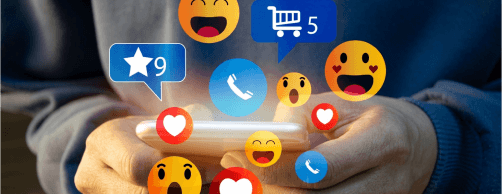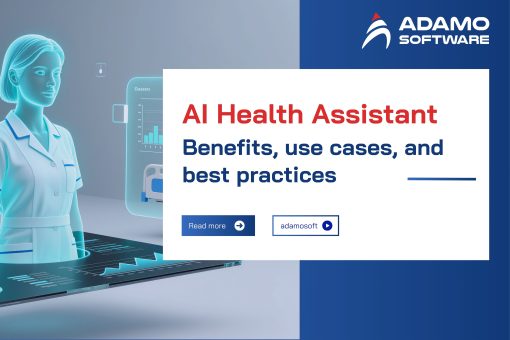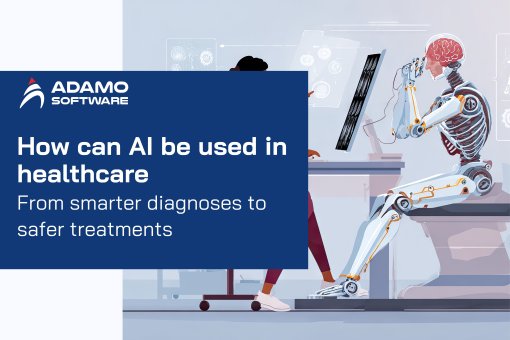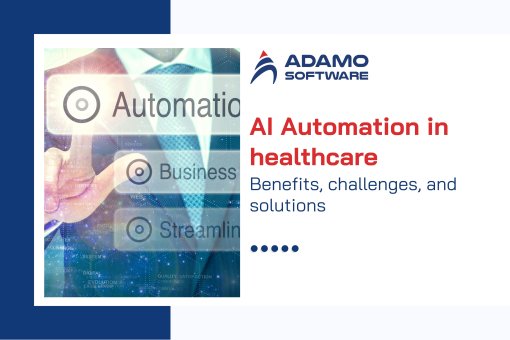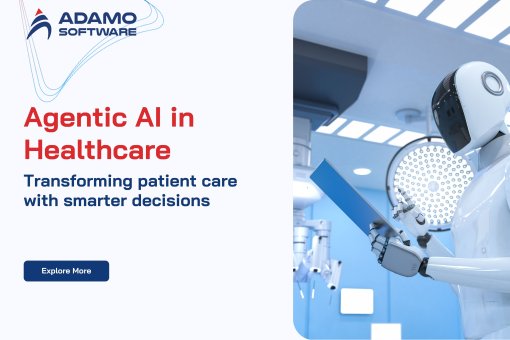Healthcare Mobile App Development: What It Costs to Build One
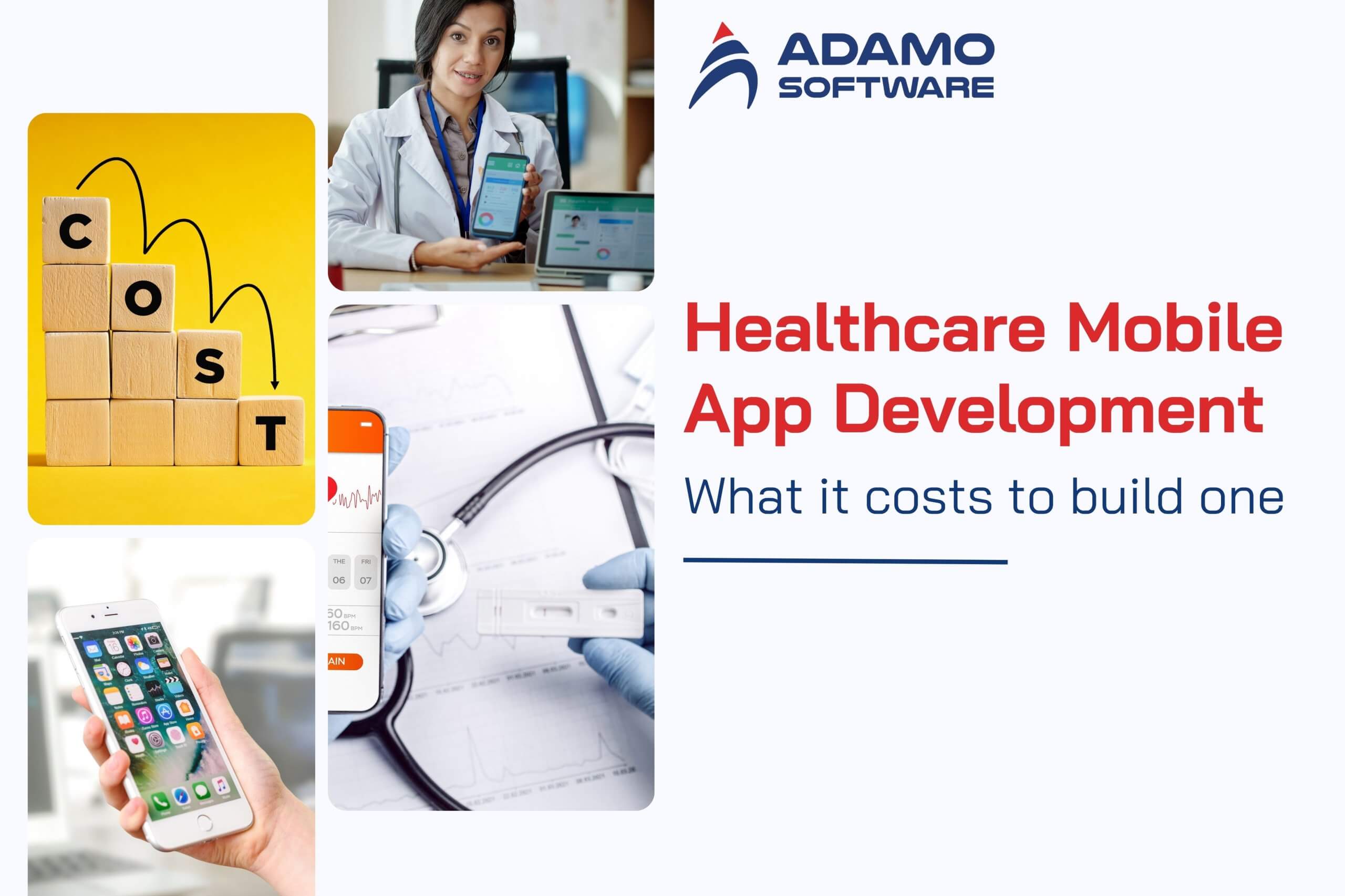
Wondering how much healthcare mobile app development costs? Get a full breakdown of pricing, platforms, and location-based rates.
Healthcare mobile app development is transforming the delivery, accessibility, and handling of medical services. Designing a safe, user-friendly, and compliant app not only entails a good idea, but it also implies wise budgeting. Before deep dive into blog today, you can explore What is a mHealth app? Market overview, benefits and current trends here.
This guide covers key cost factors in healthcare mobile app development, including complexity, platforms, and regional differences.
We’ll primarily explore the following key subjects:
- Main factors influencing healthcare mobile app development cost
- Cost breakdown for healthcare mobile app development
- The differences in the cost of each area for healthcare mobile app development
Whether as a new or old healthcare provider, these guides will allow you to make smarter, more educated decisions.
I. What are the main factors influencing Healthcare Mobile App Development cost?
Numerous variables can influence how the cost of creating a healthcare mobile app fluctuates. Based on each of the factors below that you choose for your app, the final cost could be very different for every project:
- Compliance and security: Apps dealing with sensitive health-related information should comply with stringent regulations and carry built-in security options.
- Features and complexity: The more intricate an app’s functionalities, the greater the time and financial investment required for its creation.
- Design and user experience: The user-sensitive design is essential to a patient and healthcare provider and can also influence the final cost.
- Platform selection: Choosing to build platforms separately affects the overall cost. This involves choosing among building on iOS, Android, the web, or all three simultaneously.
Compliance and Security
Healthcare mobile app development cannot be conducted without security and compliance. The apps should comply with regional health data, such as HIPAA (in the US), GDPR (in the EU), or any other regulations.
These regulations entail protection using encryption, safe authentication, access control, and timely security auditing. Complying with the standards increases the length of time and development costs.
Nevertheless, this is necessary if you do not want to get into a lawsuit later, having lost user information.
Explore Our Tailor-made Software Development Solutions
We are confident in providing end-to-end software development services from fully-functioned prototype to design, MVP development and deployment.
Features and Complexity
The quantity and complexity of features directly escalate the cost and duration of your healthcare mobile app development project.
Complex tasks like appointment scheduling or patient profiles may be constructed faster and cheaper. In contrast, features like video consultations and AI symptom checkers are significantly more expensive.
The clever way out of this is to release with the basic functionality, and slowly add the features based on user input.
Design and User Experience
Healthcare mobile app development requires great design.
That’s because patients need to find your app natural, and healthcare professionals need it to be effective. A misleading interface or bad UX may result in risky errors in the healthcare environment.
It must also be user-friendly to disabled users or ordinary people who do not know technology well.
Creating excellent UI/UX design requires time and skills, thus it raises the cost of development, but it is worth it.
Platform Choice
The platform you select is a crucial factor in determining the overall expense of developing a healthcare mobile app.
For example, native applications are made to fit iOS or Android. They provide the best performance, and they need their development teams.
Another option is using multiple coding on several platforms with a single code base is possible using cross-platform frameworks such as Flutter. This helps save time and money.
Choosing web applications costs less and is simple to maintain, although they might not have all the native capabilities. An alternative is progressive web apps. This provides a hybrid experience, where offline and mobile-like features are available at a lower price.
II. Cost breakdown for Healthcare Mobile App Development
No price tag applies everywhere. The pricing of healthcare mobile app development depends on what you expect your app to do, what it looks like, and the platforms used.
The following are the most significant cost drivers that you must consider:
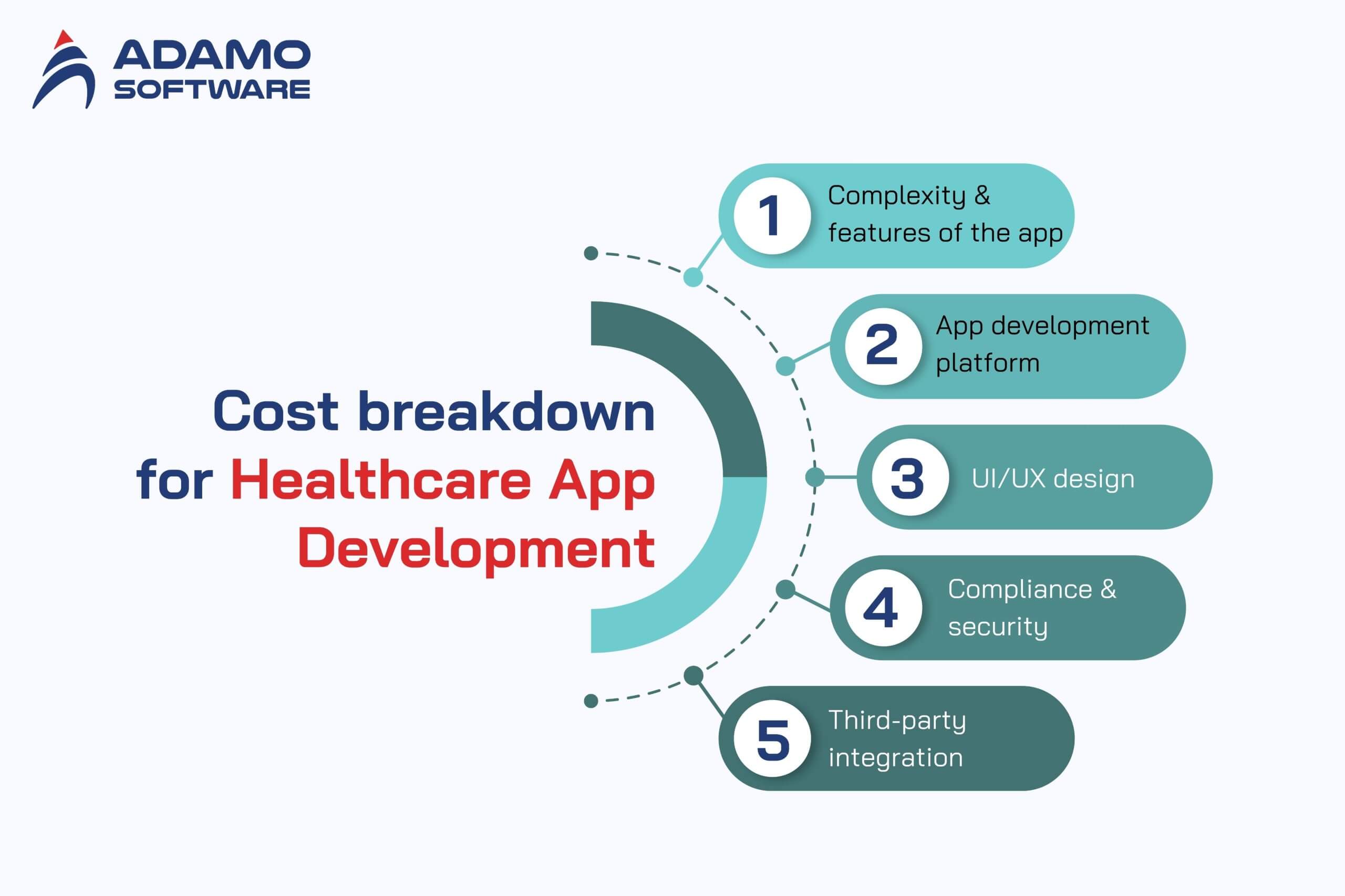
- Complexity and Features of the apps: The feature-rich apps are more complex to create and cost more.
- App-development platform: Using iOS, Android, or cross-platform influences the price, project timeframe, and app performance.
- UI/UX design: Design affects usability and user satisfaction, and it is imperative for a healthcare app.
- Compliance and security: Regulatory regulations and patient data protection require time and testing, increasing costs.
- Third-party integration: The greater the number of services your app integrates with, the greater the development cost, and the budget.
1. Features and Complexity of App
The range and usability of your application directly affect the cost of development.
It is straightforward to develop and maintain apps that only do one or two tasks, such as displaying test results or booking appointments. In contrast, an app that enables video consultations, monitors health, or uses AI for diagnostics is significantly more complex.
According to functionality, healthcare apps tend to be divided into three categories:
- Basic applications usually cost you some 20,000 to 50,000 dollars to build. These contain basic functions such as reminders and setting up appointments.
- Apps falling into the category of moderately higher complexity typically cost between $50,000 and $100,000. They often provide the ability to message, chat, or integrate wearables with physicians.
- The cost of advanced healthcare applications can be more than 100,000 dollars or even several times more. This is based on the degree of customization and support of features like AI, real-time data sync, or EHR integration.
The greater the list of features you desire, the more screens, logic, and backend services they will require, which adds time and expense to the development process.
2. App Development Platform
You should always use the right platform to manage costs and be within reach of your target users. For healthcare mobile app development, there are three primary directions you can consider:
iOS Application development:
Apps developed on iOS are created to work with Apple products – they can be iPhones, iPads, and Apple Watches. They use Swift or Objective-C and have to perform up to exceedingly high Apple standards concerning their privacy.
The reasons to use iOS:
- Apple has strong encryption of its data, and it is suitable for HIPAA-compliant applications.
- The average iOS user will also be more likely to pay premium amounts for healthcare services.
- Reduced device variety translates into easier development, testing, and upgrading.
The Android App Development:
Android applications are meant for diverse mobile brands such as Samsung, Google, and Xiaomi. They are created on Java or Kotlin and constitute more extensive testing because of the diversity of hardware.
Reasons to choose Android:
- Android commands a significant global market presence, especially prominent in emerging economies.
- It is flexible and admits custom, complex healthcare solutions. The
- Google Play Store is less strict on launching and associated app review.
The price tag for an Android application generally falls within the range of $20,000 to $120,000. However, it depends on the number of devices it should support and the features the app should have.
Cross-Platform App Development:
Cross-platform apps are also common and often have a standard code base to execute on both Android and iOS. Some of the frameworks that are frequently used for this type of app are Flutter, React Native, and Xamarin.
Reasons to go cross-platform:
- It is easier and cheaper to develop.
- Maintenance and updates on each of the platforms are easier.
- Perfect in situations where MVPs are concerned or when cash flow is tight.
When you elect to go this way, it is common to spend between 30,000 and 100,000 dollars on cross-platform development.
3. UI/UX Design
The UI/UX design in healthcare applies not only to the aesthetic qualities of a system but also to its usability, comprehensibility, and even safety.
Hence, a well-designed app must be user-friendly, always available, and respond quickly even under stressful circumstances.
The expense associated with a healthcare mobile app’s user interface and user experience (UI/UX) design fluctuates based on several factors.
- Each type of screen and user flow
- Personalized icons, drawings, or animations
4. Compliance and Security
Medical applications work with very sensitive data; as such, security and adherence are not optional but a must.
You will have to comply with some laws, including:
- HIPAA (the US)
- In Europe, GDPR (in Europe)
- A set of interoperability standards, such as HL7 or FHIR
Security measures things like end-to-end encryption, secure login mechanisms, biometric tools, and access control will have to be enforced.
You will also have to consider:
- Common code checkups
- Legal consultations
- On-cloud/on-premise data storage compliance
The cost of achieving compliance and realizing security can cost between 5,000 dollars and 40,000 dollars, or even higher. This variation depends on your security setup and legal requirements.
5. Third-Party Integrations
Most healthcare applications cannot function without the support of external systems. Depending on the objective, you may require integration with:
- Electronic Health Records (EHRs) systems
- APIs of telemedicine (such as Zoom or Twilio)
- Payment gateway (such as Stripe or PayPal)
- AWS, Google Cloud, storage services (AWS, Google Cloud)
- Health data application programming interfaces (APIs), like Apple HealthKit or Google Fit.
- Artificial intelligence tools or chatbot platforms
Every integration has additional development and testing. It also implies being compatible in the long term.
Integrating third parties can cost between 2,000 and 50,000 dollars on average, depending on their complexity and the number of systems to be linked.
III. The differences in the cost of each area for Healthcare Mobile App Development
You need to consider the location of your development team because healthcare mobile app development costs vary a lot. These are places where a skilled developer is very costly to employ, like in the United States and Western Europe. For example, on average, software engineers in the US take home a salary of 103,620 dollars yearly. In Germany, France, and the UK, the wage per hour is between 56 and 82 dollars.
To make it cheaper, many companies consider outsourcing to such places as Ukraine, Poland, China, the Philippines, and Taiwan. These are the places where developer rates are usually lower than half of a Western rate. To illustrate, in Ukraine, healthcare app developers’ average rate is about 42 dollars per hour.
Among such countries with affordable rates, Vietnam has been one of the outstanding destinations for healthcare mobile app development.
Ready to Outsource?
Discover how we can transform your business with expert IT solutions.
Vietnam has one of the cheapest software development prices in the world, and it offers a lot compared to its price. Vietnam is not only affordable, but also of high quality and experience. A large proportion of the Vietnamese engineers have assisted clients located in the US, Europe, and Australia. They can provide expertise and domain knowledge in healthcare projects.
Year after year, Vietnam’s IT outsourcing industry keeps getting better, and it’s booming. Nowadays, Vietnamese teams can meet global requirements related to UX design, security, compliance, and integration with healthcare systems.
Ultimately, Vietnam is quickly becoming an appealing location for healthcare mobile app development. Not only are the development rates here often more competitive than in Eastern Europe, but Vietnam’s costs are also lower than many other Asian nations. The country is quickly building a solid reputation for the caliber of its work.
The table below illustrates the variation in the average development costs in the different regions so that you can better compare your choices:
| Region | Average Cost (USD/hour) |
| Western Europe (France, Germany, UK) | $56 – $82 |
| United States | $49 – $56+ |
| Brazil | $45 |
| Poland | $43 |
| Ukraine | $42 |
| China | $36 |
| India | $31 |
| Philippines | $26 |
| Vietnam | $9.40 |
IV. Final thoughts

All in all, the cost of development, platform choices, design needs, security issues, and local labor rates are all vital for mobile app success. Choosing the right location and approach for your healthcare mobile app development can greatly impact your success.
This is why working with partners like Adamo Software is a perfect choice for you. Adamo stands out as a leading-edge software development company in Vietnam. We have expertise in the healthcare technology sector and a successful history of implementing scalable, secure, and user-friendly software.
Most importantly, we are cost-competitive and provide technical expertise supported by over 150 talented engineers with experience in international healthcare projects.
If you have a healthcare app idea, Adamo Software is ready to help bring it to life as a trusted development partner. Contact us today!
FAQs
1. What costs should I expect when building a healthcare app?
Healthcare mobile app development has many costs outside of coding and design. You must consider adherence to regulations such as HIPAA, cloud infrastructure, partnerships, integration, security levels, and the professional design of UI/UX.
Other costs, including testing, quality checks, and after-launch costs in maintenance and marketing, also add to the budget sum. Your total investment would be more accurately estimated if you consider all those factors for your healthcare mobile app development project.
2. Can I update my healthcare app after it launches?
Of course, this is an essential aspect of successful healthcare mobile app development. After the launch, you can improve performance, solve bugs, or add capabilities. User feedback and data analysis should guide updates, and these updates need to work with new operating systems and devices.
Also, back-end infrastructure and API stability are key factors that should be understood and reviewed. They are essential for building out and maintaining long-term directions of growth while ensuring a consistent experience for the user.
3. Why is HIPAA compliance substantial for healthcare apps?
Compliance with HIPAA matters in healthcare mobile app development because it secures sensitive patient information. As applications frequently deal with electronic Protected Health Information (ePHI), they need high-grade encryption, controls of who can access it, and sufficient user verification.
4. How do I choose the right healthcare app developer?
To get the best partner for healthcare mobile app development, you should go through their experience in that industry and their expertise. Look for developers with an extensive healthcare portfolio who are proficient in iOS, Android, or cross-platform tools. Additionally, ensure that they comply with specific data security requirements.
Besides, review their case studies, client feedback, and post-launch support strategies to assess if they can deliver a reliable healthcare solution.




